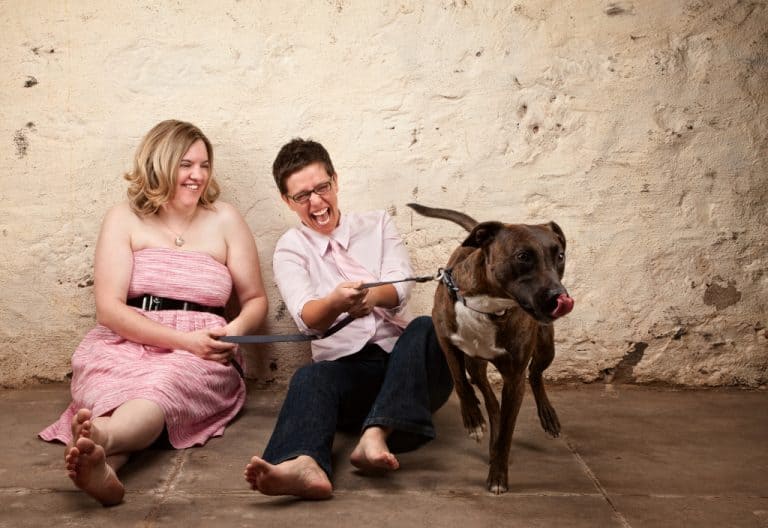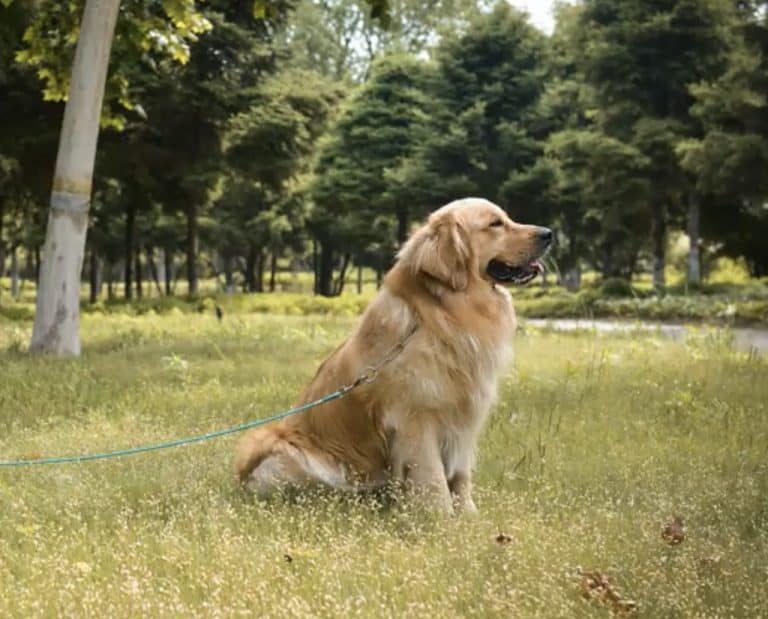Does your dog yank or pull you when walking on a leash?
And you are tired of trying to stop them from lunging at people and squirrels?
Now you are looking for solutions to stop that pulling habit and make the walks less stressful and more enjoyable?
Then, you’ve come to the right page!
Here you will find the 7 top-rated no-pull dog harnesses that can reduce or even eliminate aggressive pulling behavior and give you better control without putting pressure on their neck!
Read More:
In A Rush? Here Are the Best No-Pull Dog Harness Quick Picks:
- Our Pick: Kurgo Tru-Fit Smart Harness
- Best for Large Dogs: 2 Hounds Design Freedom No Pull Harness
- Best Value: Rabbitgoo No-Pull Dog Harness
- Best for Small Dogs: PetSafe Easy Walk Deluxe Dog Harness
- Best for Leash Reactive Dogs: Kurgo Journey Air Dog Harness
** Best No Pull Dog Harnesses Comparison
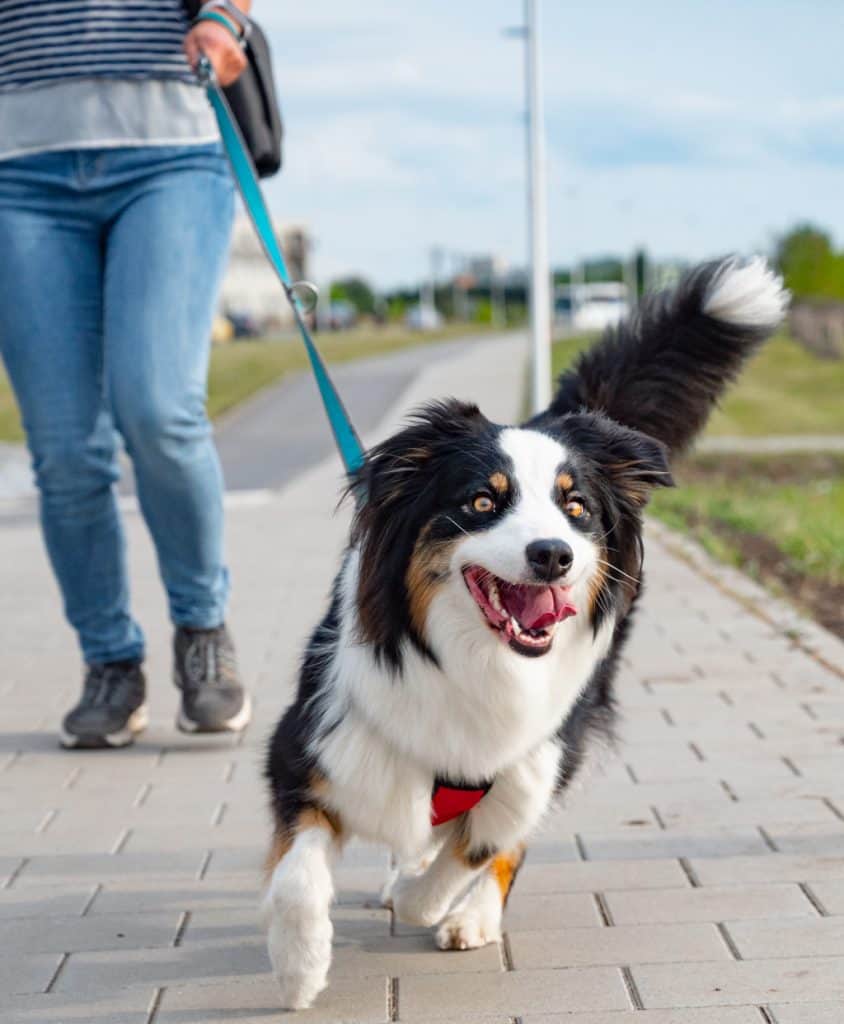
What Are No Pull Harnesses for Dogs?
As its name implies, a no-pull harness is a type of harness that discourages, minimizes, or even eliminates a dog’s aggressive pulling behavior. In short, it stops your fido from pulling you away on walks. While there are many training tools out there on the market, anti-pull harnesses are more popular and a much safer option.
But how does it work?
Unlike dog collars, a no-pull harness wraps around your pup’s torso and front legs, with a clip on the chest that puts control ahead of them. So when they tug on the lead, the tension on the leash will cause them to turn and allow you to steer them to the side with ease.
So, how are anti-pull harnesses a safer option?
Well, this type of harness will disperse the pressure more evenly over a larger area of your dog’s body instead of their neck. In other words, it removes the strain on their throat and, as a result, prevents all possible neck injuries.
No Pull Harness Buyers’ Guide :
Important Features to Consider
Not all anti-pull harnesses are the same. And to help you make an informed decision, we have listed some of the things you need to consider when picking one for your furry friend.
Read on to find out.
1. Types of Anti-Pull Harnesses: Front Clip vs. Back Clip vs. Head Halter
- Front Clip Harnesses. A front clip harness is what you will need to stop your fido from pulling. There’s a clip fitted on the lower portion of your dog’s chest, and when your dog pulls, the leash will give a tug on their chest and turn them towards you, ultimately keeping them from moving forward. The flip side is that the lead can get tangled around your dog’s front legs if you are not careful.
- Back Clip Harnesses. These harnesses have a leash attachment on the back of your pup and are only suitable for well-behaved dogs. And trust us, you don’t want to use the back clip if you are trying to correct the pulling behavior. The reason is that it can trigger your dog’s natural resistance to pressure, known as the opposition reflex, which will only encourage them to pull. Note that some manufacturers call this type of harness an anti-pull harness, which is why we decided to put it down here as well, just so you are aware that they don’t help discourage dogs from pulling at all.
- Head Harnesses. Head harness, also known as a head halter, is another training tool that dog owners use to stop their canines from pulling on walks. With a strap that encircles a dog’s muzzle and another strap that wraps around the neck. And you notice we didn’t recommend any of these products. The reason being is that they can jerk a dog’s head and cause neck or spinal injuries.
2. Size and Adjustability
Getting the right size no-pull harness for your dog is crucial. It has to be just right as too tight can cause chafing, sores, and irritation. And a loose-fitting harness will give your canine a better chance of escaping from it. So, make sure to measure your pup correctly. The anti-pull harness you choose also needs to have adjustable straps to ensure it can fit your four-legged friend snugly and comfortably.
3. Attachment Points
The next thing that you need to pay attention to is the number of leash attachment points. You will find some harnesses have both front and back clips, while some come with a single leash ring only like the PetSafe Easy Walk Deluxe Dog Harness and Softouch Sense-ation No-Pull Dog Training Harness. Make sure to choose the ones equipped with a front clip as it is the main feature that keeps your dog from pulling.
4. Durability and Padding
Also, the no-pull harness needs to be durable and robust enough to withstand your dog’s pulling force, like the Kurgo Tru-Fit No Pull Dog Walking Harness and 2 Hounds Design Freedom No Pull Dog Harness. And it would be a better idea to pick those that have padding in the high-friction areas as well to protect your dog’s skin and keep them comfortable.
5. Reflective Material
Lastly, consider anti-pull harnesses with reflective material. It is an optional feature but can be very helpful if you plan to walk your fido at night. It helps to make them more visible to motorists in dim light situations and, as a result, keeps them safe.
1. Our Top Pick - Kurgo Tru-Fit No Pull Dog Walking Harness
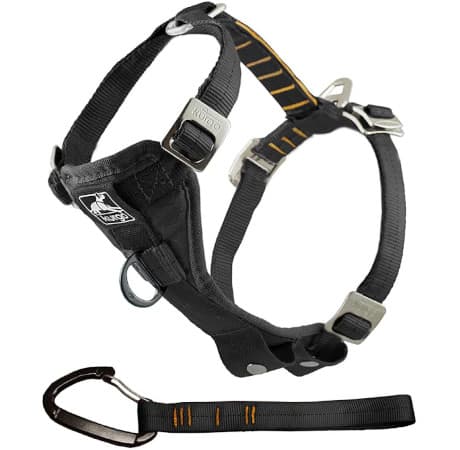
Do you have a large dog or a rambunctious dog who loves pulling? If so, you would probably want to consider the Kurgo Tru-Fit No Pull Dog Walking Harness.
It features a front D-ring that allows you to train your dog not to pull and a back leash attachment for regular walking and jogging. Made of durable ripstop fabric and all-steel nesting buckles to ensure it can hold up to your dog’s strength, coupled with padding in the chest plate to prevent chafing and irritation. It also comes with 5 adjustment points to fit a wide range of dog body types.
What’s more, this anti-pull harness is crash tested and includes a dog tether compatible with any car seat belt system.
Features:
- Ripstop fabric
- All-steel nesting buckles
- No-pull training clip
- Back leash attachment
- Padded chest plate
- Five adjustment points
- Crash tested
- Includes a dog tether
- Comes with a lifetime warranty
- Suitable for large and high-energy dogs who pull
- Durable
- Comfortable for most dogs
- Has five points of adjustment for a customizable fit
- Not only can it be used as a walking harness, but also a car harness
- Includes a hassle-free lifetime warranty
- Slightly more expensive
- No reflective material
2. Best for Big Dogs - 2 Hounds Design Freedom No Pull Dog Harness
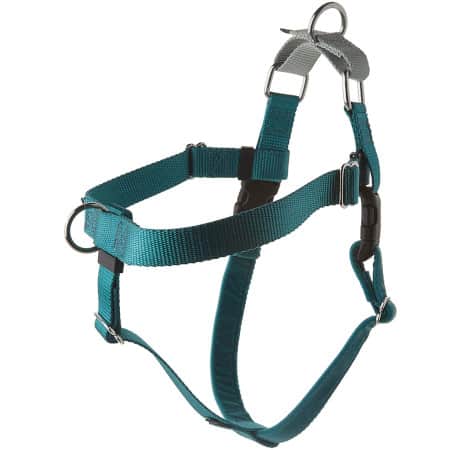
Don’t be fooled by its look. The 2 Hounds Design Freedom No Pull Dog Harness is one of the best anti-pull harnesses that can handle large and powerful heavy pullers.
It is very well-made and recommended by many dog trainers. With a patented martingale loop on the back of the harness that gently tightens around your furkid’s chest to discourage pulling and makes it more difficult for them to escape. Coupled with a lower leash attachment point that sits below the trachea and above the leg muscles for greater control and prevents choking and gagging.
Also built with your dog’s comfort in mind, it has a soft Swiss velvet lining under each armpit strap to prevent rubbing and sores.
Features:
- Patented no-pull control loop design
- Two leash clips
- Heavy-duty nylon
- Stainless steel hardware
- Swiss velvet lining
- Four points of adjustability
- Suitable for dog owners who have an aggressive puller
- Recommended by many dog trainers
- Its dual leash attachment points offer better control
- The velvet lining that goes behind the legs can prevent chafing
- Equipped with patented martingale loops to reduce twisting and straining
- Has four adjustment points for a comfortable fit
- Offers chewing replacement
- No reflective material
3. Best Value - Rabbitgoo No-Pull No-Choke Dog Harness
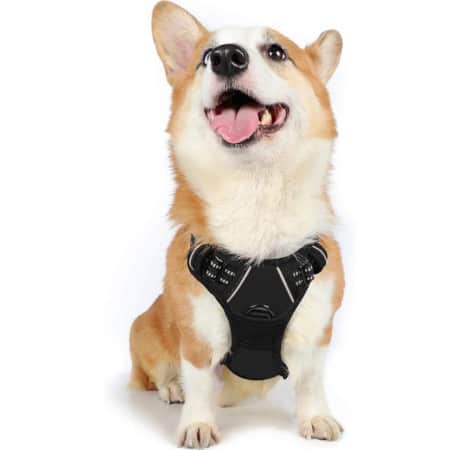
The Rabbitgoo No-Pull No-Choke Dog Harness is a very popular harness that can correct your pup’s pulling behavior.
It comes with 2 sturdy metal leash rings. One on the chest allows you to steer your dog back towards you when they try to pull without choking or hurting their neck, while the one on the back is for casual walks. Made of durable nylon Oxford fabric and padded with soft cushions to protect your dog’s skin. Plus, a top handle for additional control.
It is easy to put on and take off and is fully adjustable to achieve a snug fit. Also, this harness has reflective material to keep your furry friend safe during walks at night.
Features:
- No-pull and no-choke design
- Durable nylon Oxford fabric
- Breathable mesh padding
- Two metal leash attachment points
- Adjustable neck and chest straps
- Two fast-release buckles
- Reflective strips
- Top handle
- Good value for money
- Suitable for medium and large size dogs who pull
- Offers two leash clips for no-pull training and casual walks
- Fully adjustable
- Easy to put on and take off
- Comes with a handle for instant control
- Has reflective material for added nighttime visibility
- Aren’t of the best quality
4. Best for Small Dogs - PetSafe Easy Walk Deluxe Dog Harness
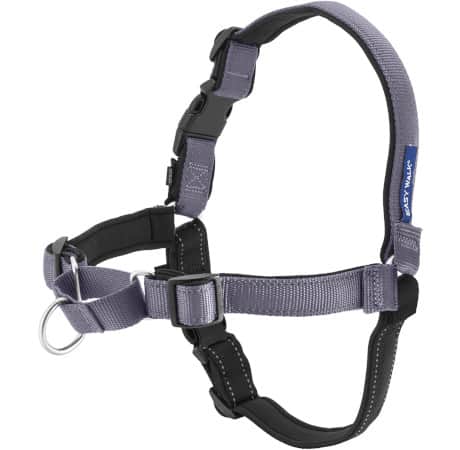
Created by a veterinary behaviorist, you can rest assured that the PetSafe Easy Walk Harness can stop your pooch from pulling.
It features a patented martingale loop and a front chest clip that allows you to gently steer your dog in the direction you are headed, with the chest strap resting across their chest to prevent injuring their throat when they tug on the lead. And that also means it won’t cause choking or gagging. Plus, the straps are padded with neoprene for added comfort and have reflective trim to ensure safety on night walks.
Not only is this best no-pull harness comfortable for most dogs to put on, but also lightweight as it has less coverage, making it one of the best options for small dogs.
Features:
- Patented martingale front-chest loop
- Padded with neoprene
- Four points of adjustability
- Quick-snap buckles
- Reflective stitching
- Great for small dogs who pull as it is lightweight and padded
- Equipped with a patented martingale loop on the chest to deter pulling and makes it harder for dogs to slip free
- It can prevent choking or neck injuries as the strap rests across the chest instead of the throat
- Adjustable for a good fit
- Has reflective stitching to provide added visibility in a low-light environment
- Easy to put on and take off
- Created by a veterinary behaviorist
- No back clip
- Lacks a strap between the front legs to help stabilize the harness
5. Best for Leash Reactive Dogs - Kurgo Journey Air Dog Harness
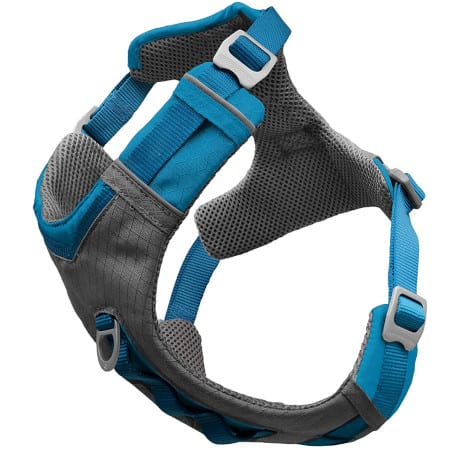
Does your dog lunge at other dogs, people, cars, squirrels, or other animals? If so, consider the Kurgo Journey Air Dog Harness.
It is a vest-style no-pull harness that includes a sturdy front D-ring to help deter your canine from pulling and a back leash clip for outdoor activities, including walking, jogging, and hiking. Made of durable ripstop fabric and lightweight aluminum hardware to ensure it can stand up to your dog’s pulling force. Plus, its V-neck design and breathable mesh padding reduce strain on the chest and neck when they suddenly lunge forward.
Additionally, it is equipped with easy on-and-off buckles and has a handle for added control. Not only that, but it is also adjustable and has reflective trims to keep your furkid safe at night.
Features:
- Durable ripstop fabric
- Lightweight aluminum hardware
- V-neck design
- Breathable mesh padding
- No-pull training clip
- Back leash attachment ring
- Easy on-and-off buckles
- Four adjustment points
- Top handle
- Reflective material
- Ideal for reactive dogs
- Includes two leash clips to allow for no-pull training and a wide range of outdoor activities
- Durable yet lightweight
- Comes with a thoughtful V-neck design and a padded chest plate to prevent chafing
- The top handle provides extra control over your dog’s movement
- Has four points of adjustments for a snug fit and reflective material to ensure safety
- Expensive
6. Softouch Sense-ation No-Pull Dog Training Harness
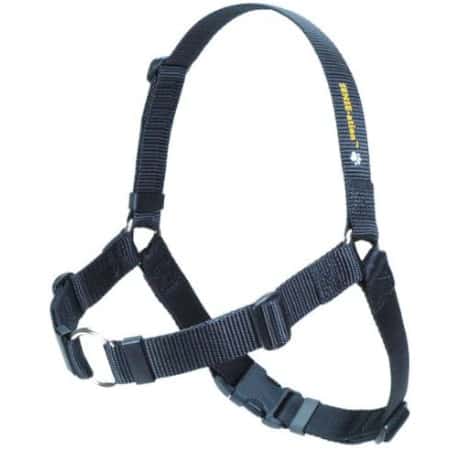
The Softouch Sense-ation No-Pull Dog Training Harness is also a great harness that you can use to teach your pup not to pull and walk nicely on a leash.
It has a simple yet effective design that gives you the ability to redirect your four-legged friend’s attention to you without injuring or stressing them. It uses a custom Softouch polyester webbing for comfort, with Duraflex plastic hardware and durable nickel-plated steel O-rings on the chest and sides to provide longevity and extra strength.
And as you would expect, this no-pull dog training harness is adjustable, which allows for a customizable fit.
Features:
- Softouch polyester webbing
- Duraflex plastic hardware
- Nickel-plated steel O-rings
- Adjustable
- Has a robust nickel-plated steel O-ring on the chest to withstand the pulling force of medium and large dogs
- Lightweight
- Easy to use
- Adjustable
- No padding
- No back clip
- Lacks a strap between the front legs to help stabilize the harness
7. Chai’s Choice Front Range Harness
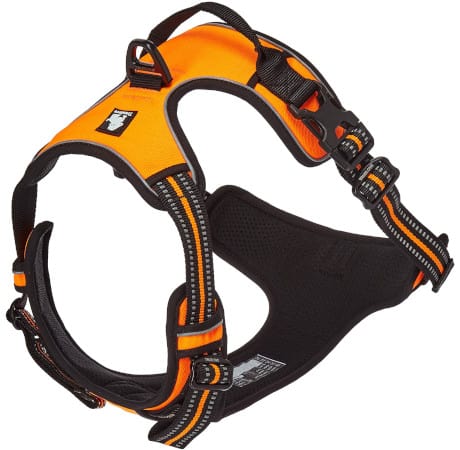
This harness from Chai’s Choice is another option that you can consider, designed to keep your pulling pup under control during walks.
Like most anti-pull harnesses, it has a durable leash ring on the chest to discourage pulling without straining your dog’s neck, ultimately preventing possible neck, spine, and windpipe injuries. Also, you have the option to attach the leash to the back of the harness. Made of durable nylon material and has soft mesh lining in the chest and belly areas to prevent rubbing and irritation.
Additionally, it comes with a high-tensile strength Duraflex buckle and a built-in handle to give you more control. Plus, the straps are adjustable and have reflective material to keep your dog visible at night.
Features:
- Durable nylon exterior
- Padded chest and belly
- Two leash attachment points
- High tensile strength Duraflex buckle
- Adjustable straps
- Built-in handle
- 3M reflective material
- Ideal for small and medium-sized dogs
- Comes with front and back leash clips
- Includes a handle for additional control
- 3M reflective material keeps your dog safe on night walks
- Not durable enough to handle large and strong pulling dogs
Anti Pull Dog Harnesses FAQ
1. Do no-pull dog harnesses work?
Yes, no-pull dog harnesses can deter dogs from pulling. With a leash clip strategically placed on the chest, it allows you to put control ahead of your pup and gives you the ability to steer them to the side when they pull.
2. How tight should an anti-pull dog harness fit?
A no-pull dog harness should fit snug and tight enough that your four-legged friend can’t wriggle out of it. But you don’t want it to be too tight and make them uncomfortable. So, ensure you can slide two fingers between the harness and your dog’s skin.
3. Can my dog hurt their neck if they pull on the leash?
Yes, if your dog pulls too hard while wearing a standard collar, it can cause neck injuries. That’s why many dog owners opt for no-pull harnesses, as they can spread out the pressure and make walking more comfortable for their pooch.
4. Will no-pull harnesses teach my dog to stop pulling?
No, no-pull harnesses won’t teach your dog leash manners. These directional harnesses are only designed to help you guide your dog away from something they want to pull towards instead of teaching them not to pull. So, training is still required.

